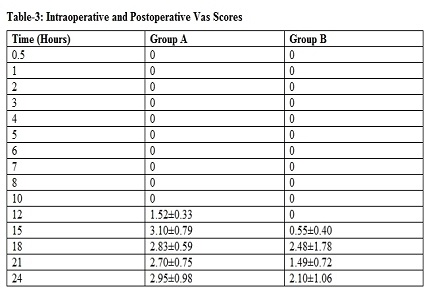Comparison of dexmedetomidine and clonidine as an adjuvant to levobupivacaine in supraclavicular brachial plexus block
Abstract
Introduction: There are always efforts to find better and safer local anaesthetics along with adjuvants for supraclavicular brachial plexus block. Levobupivacaine has strongly emerged as a safer alternative for regional anaesthesia than its racemic sibling bupivacaine. Alpha 2 agonists are combined with local anaesthetics to improve the quality of regional anaesthesia.
Method: A prospective randomized study was carried out which included 60 adult patients between the ages of 18-65 years of ASA grade I and II who underwent upper limb orthopaedic surgeries. Group A received 30 ml of 0.5% levobupivacaine with 150µg of clonidine and Group B received admixture of 30 ml of 0.5% levobupivacaine with 100 µg of Dexmedetomidine. Onset, duration of sensory and motor blockade and duration of analgesia were observed.
Results: Duration of postoperative analgesia in group A was 14.36±0.36 minutes and in group B was 16.90±2.29 minutes. Hence from the above observation, the duration of analgesia in group B is longer than group A which is statistically highly significant (p<0.001).
Conclusion: Dexmedetomidine as an adjuvant 0.5% levobupivacaine is more effective in prolonging the duration of sensory and motor block and post operative analgesia compare to clonidine as an adjuvant to 0.5% levobupivacaine.
Downloads
References
Nielsen KC, Steele SM. Ambulatory evaluation and safety considerations. Tech Reg Anesth Pain Management. 2004;8(2):99-103. DOI: http://dx.doi.org/10.1053/j.trap.2003.12.001
Klein SM, Evans H, Nielsen KC, Tucker MS, Warner DS, Steele SM. Peripheral nerve block techniques for ambulatory surgery. Anesth Analg. 2005;101(6):1663-76. DOI: https://doi.org/10.1213/01.ANE.0000184187.02887.24.
Ward ME. The interscalene approach to brachial plexus. Anaesthesia 1974;29:147-57. DOI: https://doi.org/10.1111/j.1365-2044.1974.tb00613.x.
Telivuo L. A new long acting local anaesthetic solution for pain relief after thoracotomy. Ann Chir Gynae Fenn. 1963;52:513-8. PMID:14083852.
Tucker GT. Pharmacokinetics of local anaesthetics. Br J Anaesth. 1986; 58:717-31.
Esmaoglu A, Yegenoglu F, Akin A, Turk CY. Dexmedetomidine added to levobupivacaine prolongs axillary brachial plexus block. Anesth Analg. 2010;111:1548–51. doi: https://doi.org/10.1213/ANE.0b013e3181fa3095. Epub 2010 Oct 1.
Winne AP. Interscalene brachial plexus block. Anesth Analg. 1970;49(3):455-66.
Swami SS, Keniya VM, Ladi SD, Rao R. Comparison of dexmedetomidine and clonidine (α2 agonist drugs) as an adjuvant to local anaesthesia in supraclavicular brachial plexus block: A randomised double-blind prospective study. Indian J Anaesth. 2012;56(3):243-9. DOI: https://dx.doi.org/10.4103%2F0019-5049.98767.
Casati A, Magistris L, Beccaria P, Cappelleri G, Aldegheri G, Fanelli G. Improving postoperative analgesia after axillary brachial plexus anesthesia with 0.75% ropivacaine. A double blind evaluation of adding clonidine. Minerva Anesthesiol 2001 May;67(5):407-12.
Culebras X, Van Gessel E, Hoffmeyer P, Gamulin Z. Clonidine combined with a long acting local anesthetic does not prolong postoperative analgesia after brachial plexus block but does induce hemodynamic changes. Anesth Analg 2001 Jan;92(1):199-204.
Gertler R, Brown HC, Mitchell DH. Dexmedetomidine: a novel sedative- analgesic agent. Proc (Bayl Univ Med Cent) 2001 Jan;14(1):13-21.
Raimo V, Juha M, Veijo S, Leena N, Virtanen R. Characterisation of selectivity, specificity and potency of dexmedetomidine as α2 adrenoceptor agonist. Eur J Pharmacol 1988;150:9–14.
Bonica JJ, Moore DC. Brachial plexus block. Am J Surg 1949;78:65-79.
Sebastian D, Ravi M, Dinesh K, Somasekharam P. Comparision of Dexmedetomidine and clonidine as Adjuvant to Ropivacaine in Supraclavicular Brachial Plexus Nerve Blocks. J of Dental and Medical Sciences 2015;14(3):91-7. DOI: 10.9790/0853-14359197.
Rao KG, Kapoor P, Chaurasiya MK, Shukla A. A randomized double blind prospective study to compare coinidine and dexmedetomidine as an adjuvant in supra-clavicular brachial block. Indian Journal of Fundamental and Applied Life Sciences. 2014;4:226-9.
Karthik G, Sudheer R, Sahajandanda H, Rangalakshimi S, Roshan K. Dexmedetomidine and clonidine as adjuvants to levobupivacaine in supraclavicular brachial plexus block: a comparative randomized prospective controlled study. JEMDS 2015;4(19):3207-21.
Hosalli V, Ganeshnavar A, Hulakund SY, Prakashappa DS. Comparison of dexmedetomidine and clonidine as an adjuvant to levobupivacaine in ultrasound guided axillary brachial plexus block: a randomized double blind prospective study. Int J Clinical and Diagnostic Research 2015; 3(2):1.



 OAI - Open Archives Initiative
OAI - Open Archives Initiative


